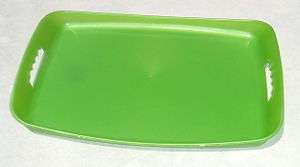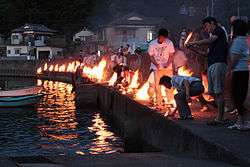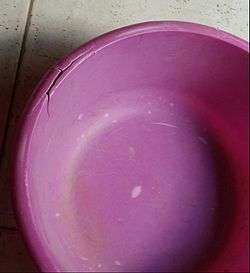Definify.com
Definition 2025
盆
盆
Translingual
Glyph origin
| Historical forms of the character 盆
| ||
|---|---|---|
| Bronze inscriptions | Large seal script | Small seal script |
 |
 |
 |
| Characters in the same phonetic series (分) (Zhengzhang, 2003) | |
|---|---|
| Old Chinese | |
| 扮 | *prɯːns, *hmroːlʔ, *pɯn, *pɯnʔ |
| 盼 | *pʰrɯːns |
| 頒 | *praːn, *bɯn |
| 朌 | *praːn, *bɯn |
| 鳻 | *praːn, *bɯn |
| 份 | *prɯn, *bɯns |
| 汃 | *pʰreːd, *prɯn |
| 玢 | *prɯn |
| 邠 | *prɯn |
| 攽 | *prɯn |
| 砏 | *prɯn, *pʰrɯn, *pʰɯn |
| 貧 | *brɯn |
| 湓 | *pʰɯːns, *bɯːn, *pʰɯns |
| 盆 | *bɯːn |
| 葐 | *bɯːn, *bɯn, *bɯn |
| 坌 | *bɯːns, *bɯnʔ, *bɯns |
| 坋 | *bɯːns, *bɯnʔ, *bɯns |
| 分 | *pɯn, *bɯns |
| 吩 | *pɯn |
| 粉 | *pɯnʔ |
| 黺 | *pɯnʔ |
| 芬 | *pʰɯn |
| 紛 | *pʰɯn |
| 衯 | *pʰɯn |
| 棻 | *pʰɯn, *bɯn |
| 氛 | *pʰɯn, *bɯn |
| 雰 | *pʰɯn |
| 忿 | *pʰɯnʔ, *pʰɯns, *bɯnʔ |
| 魵 | *pʰɯnʔ, *pʰɯns, *bɯn, *bɯnʔ |
| 汾 | *bɯn |
| 羒 | *bɯn |
| 枌 | *bɯn |
| 棼 | *bɯn |
| 妢 | *bɯn |
| 梤 | *bɯn |
| 馚 | *bɯn |
| 鼢 | *bɯn, *bɯnʔ |
| 蚡 | *bɯn, *bɯnʔ |
| 弅 | *bɯnʔ |
| 秎 | *bɯns |
Phono-semantic compound (形聲, OC *bɯːn) : phonetic 分 (OC *pɯn, *bɯns) + semantic 皿.
Han character
盆 (radical 108 皿+4, 9 strokes, cangjie input 金尸竹廿 (CSHT), four-corner 80107, composition ⿱分皿)
References
- KangXi: page 793, character 5
- Dai Kanwa Jiten: character 22959
- Dae Jaweon: page 1208, character 7
- Hanyu Da Zidian: volume 4, page 2558, character 7
- Unihan data for U+76C6
Chinese
|
simp. and trad. |
盆 | |
|---|---|---|
Pronunciation
- Mandarin
- (Standard Chinese, Beijing)+
- Pinyin:
- Zhuyin: ㄆㄣˊ
- Wade-Giles: p'ên2
- Gwoyeu Romatzyh: penr
- IPA (key): /pʰən³⁵/
-

- (Standard Chinese, Beijing)+
- Cantonese
- (Standard Cantonese, Guangzhou)+
- Jyutping: pun4
- Yale: pùhn
- Cantonese Pinyin: pun4
- IPA (key): /pʰuːn²¹/
- (Standard Cantonese, Guangzhou)+
- Hakka
- (Sixian, incl. Miaoli and Meinong)
- Pha̍k-fa-sṳ: phùn
- Hakka Romanization System: punˇ
- Hagfa Pinyim: pun2
- IPA: /pʰun¹¹/
- (Sixian, incl. Miaoli and Meinong)
- Min Nan
- (Hokkien)
- Pe̍h-ōe-jī: phûn
- Tâi-lô: phûn
- Phofsit Daibuun: phuun
- IPA (Xiamen): /pʰun²⁴/
- IPA (Quanzhou): /pʰun²⁴/
- IPA (Zhangzhou): /pʰun¹³/
- IPA (Taipei): /pʰun²⁴/
- IPA (Kaohsiung): /pʰun²³/
- (Hokkien)
| Rime | |
|---|---|
| Character | 盆 |
| Reading # | 1/1 |
| Initial (聲) | 並 (3) |
| Final (韻) | 魂 (55) |
| Tone (調) | Level (Ø) |
| Openness (開合) | Closed |
| Division (等) | I |
| Fanqie | 蒲奔切 |
| Reconstructions | |
| Zhengzhang Shangfang |
/buən/ |
| Pan Wuyun |
/buon/ |
| Shao Rongfen |
/buən/ |
| Edwin Pulleyblank |
/bwən/ |
| Li Rong |
/buən/ |
| Wang Li |
/buən/ |
| Bernard Karlgren |
/bʱuən/ |
| Expected Mandarin Reflex |
pén |
| Baxter-Sagart system 1.1 (2014) | |
|---|---|
| Character | 盆 |
| Reading # | 1/1 |
| Modern Beijing (Pinyin) |
pén |
| Middle Chinese |
‹ bwon › |
| Old Chinese |
/*[b]ˤə[n]/ |
| English | bowl, basin |
Notes for Old Chinese notations in the Baxter-Sagart system: * Parentheses "()" indicate uncertain presence; | |
| Zhengzhang system (2003) | |
|---|---|
| Character | 盆 |
| Reading # | 1/1 |
| No. | 3144 |
| Phonetic component |
分 |
| Rime group |
文 |
| Rime subdivision |
1 |
| Corresponding MC rime |
盆 |
| Old Chinese |
/*bɯːn/ |
Noun
盆
- large basin, tub (Classifier: 個/个 m)
- pot
- unit of volume equal to 12 斗 (dǒu) and 8 升 (shēng) (128 liters)
Compounds
Classifier
盆
References
- 盆 in CEDICT on MDBG
Japanese
Kanji
Readings
Etymology 1

| Kanji in this term |
|---|
| 盆 |
|
ぼん Grade: S |
| on'yomi |
From Middle Chinese 盆 (bwon). Compare modern Mandarin 盆 (pén).
Pronunciation
Noun
- a tray (for carrying e.g. dishes)
- (archaic) a flat earthenware pot, bowl, or basin
- short for 盆茣蓙 (bon goza), a woven rush mat for rolling or throwing dice in gambling
- a gambling den, a place where gambling happens
- a gamble, a match, a contest
- a household, a residence, a home (by extension from the sense of having one's own serving tray)
- a place for a tryst
- the circular area of a 回り舞台 (mawari butai, “revolving stage”) (from its resemblance to a round serving tray)
Derived terms
Idioms
|
Synonyms
Etymology 2

| Kanji in this term |
|---|
| 盆 |
|
ぼん Grade: S |
| on'yomi |
Short for 盂蘭盆 (Urabon) or 盂蘭盆会 (Urabon'e), from Middle Chinese 盂蘭盆 (hju lan bwon) or 盂蘭盆會 (hju lan bwon hwajH) (compare modern Mandarin 盂蘭盆/盂兰盆 (yúlánpén) or 盂蘭盆會/盂兰盆会 (yúlánpénhuì)), a transcription of Pali उल्लुम्पन (ullumpana, “raising, helping”), noun inflection of Pali verb उल्लुम्पयति (ullumpayati, “to raise up, to help”).
A number of Japanese dictionaries state that this term derives from Sanskrit उल्लम्बन (ullambana), purportedly meaning “hanging upside-down” in reference to the souls of the dead being tortured in **** by being strung up by their feet.[3][1][4][5] However, the Sanskrit word would be the noun inflection of verb उल्लम्बयति (ullambayati, “to hang something up”), with no inherent “upside-down” meaning. Moreover, the purported Sanskrit term's meaning of “hanging upside-down” does not match very well, given that the urabon ceremonies are about helping the dead. And lastly, Buddhism was transmitted by speakers of Pali. All of this suggests that explanations of the dead hanging upside-down in **** are more likely to be folk etymologies based on a mistaken connection to Sanskrit, rather than a more direct semantic link to Pali.
Pronunciation
- On'yomi: Goon
- (Tokyo) ぼん [bóꜜǹ] (Atamadaka - [1])[1][2]
- (Tokyo) ぼん [bòń] (Heiban - [0])[1]
- IPA(key): [bõ̞ɴ]
Noun
Proper noun
- the Obon or Bon Festival, an event with Buddhist roots, celebrated on July 15
Derived terms
|
Idioms
|
Synonyms
See also
- List of festivals in Japan on Wiktionary
- List of festivals in Japan on Wikipedia
Etymology 3
| Kanji in this term |
|---|
| 盆 |
|
ぼに Grade: S |
| Irregular |
Alteration from bon, where the final moraic n changed to ni.[3][1] Compare the Japanese given name 紫苑 and the similar development of reading Shioni from Shion.
Obsolete reading.
Pronunciation
- IPA(key): [bõ̞ni]
Proper noun
盆 (hiragana ぼに, romaji Boni)
- (obsolete) the Obon festival (see above)
References
- 1 2 3 4 5 2006, 大辞林 (Daijirin), Third Edition (in Japanese), Tōkyō: Sanseidō, ISBN 4-385-13905-9
- 1 2 1998, NHK日本語発音アクセント辞典 (NHK Japanese Pronunciation Accent Dictionary) (in Japanese), Tōkyō: NHK, ISBN 978-4-14-011112-3
- 1 2 1988, 国語大辞典(新装版) (Kokugo Dai Jiten, Revised Edition) (in Japanese), Tōkyō: Shogakukan
- ↑ 1995, 大辞泉 (Daijisen) (in Japanese), Tōkyō: Shogakukan, ISBN 4-09-501211-0
- ↑ 1997, 新明解国語辞典 (Shin Meikai Kokugo Jiten), Fifth Edition (in Japanese), Tōkyō: Sanseidō, ISBN 4-385-13143-0
Korean
Hanja
盆 • (bun) (hangeul 분, revised bun, McCune-Reischauer pun, Yale pun)
- This term needs a translation to English. Please help out and add a translation, then remove the text
{{rfdef}}.
Vietnamese
Han character
盆 (bồn, buồn, vồn, bòn, dồn)
- This term needs a translation to English. Please help out and add a translation, then remove the text
{{rfdef}}.
Readings
- Nôm: bòn, bồn, buồn, buồng
References
- Thiều Chửu : Hán Việt Tự Điển Hà Nội 1942
- Trần Văn Chánh: Từ Điển Hán Việt NXB Trẻ, Ho Chi Minh Ville, 1999
- Vũ Văn Kính: Đại Tự Điển Chữ Nôm , NXB Văn Nghệ, Ho Chi Minh Ville, 1999
